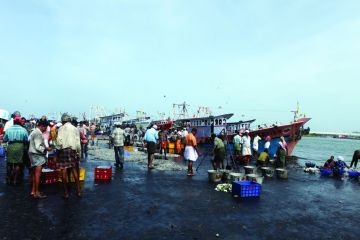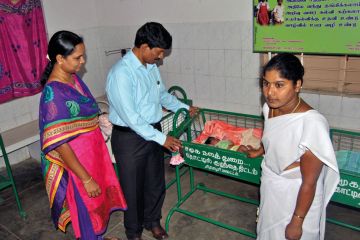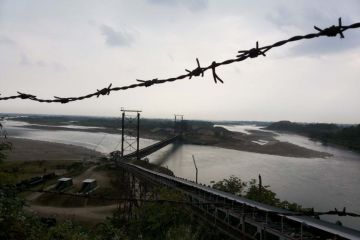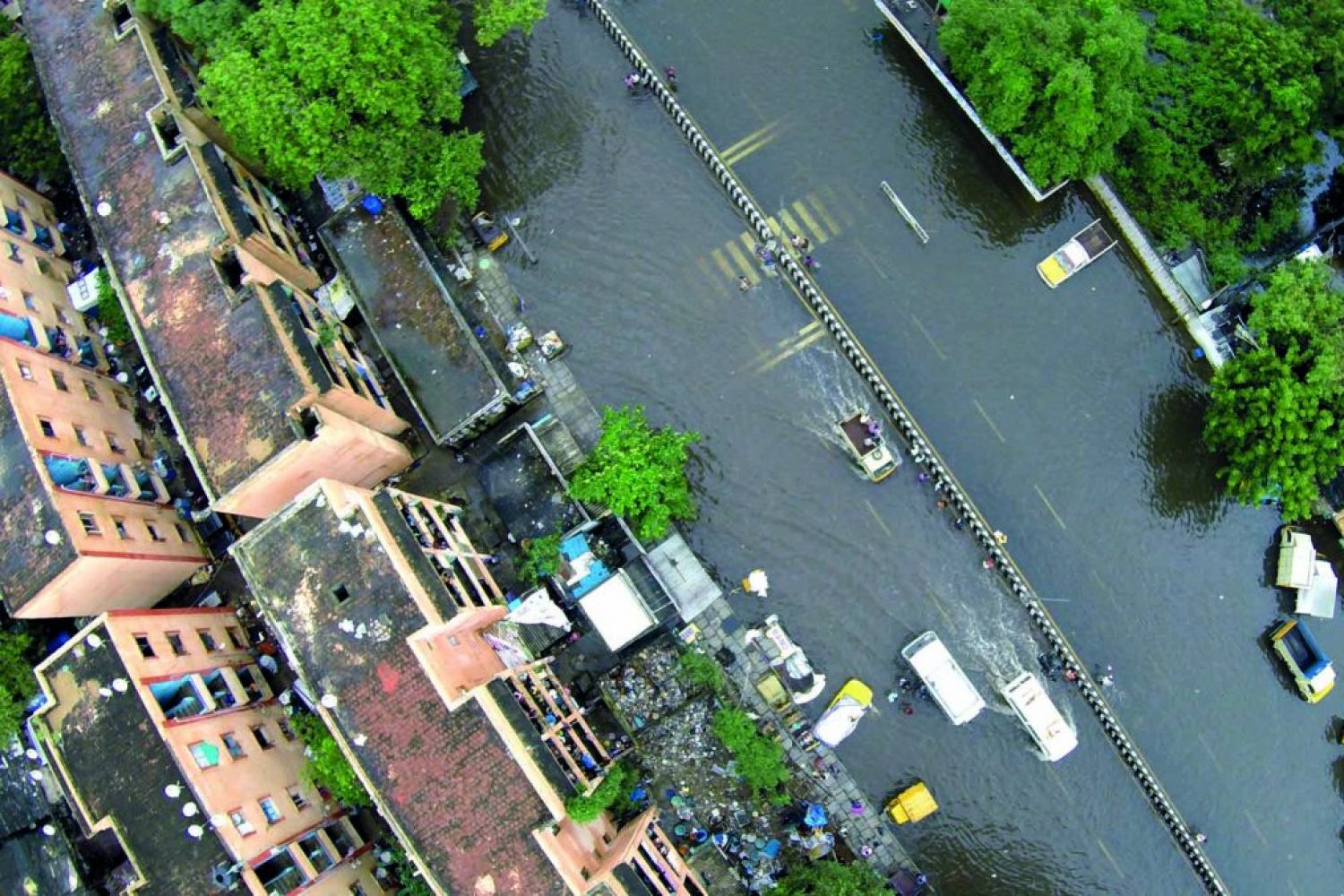
The MTC bus
driver, one hand clutching his jaw and the other sitting dead on the steering
wheel, was blinking hard and fast like bursts from a machine gun as the vehicle
barrelled down MTH Road in north Chennai. The road was empty and intact, the
sky blue, and the rain faint. There were a dozen or so passengers, mostly old
men and women, and a young woman carrying two large cans of idlis and pongal to
distribute to those whose houses had flooded. Her house had survived, and she
had heard that a great many people were without food and water.
The bus, too, was a survivor. The night before water had crept up to its scratched windshield from the top of which dangled a broken wiper, but had stopped before it could break the glass, the driver said. It had whooshed its way inside, from the cracks and holes of the aluminium floorboard, from the cut-outs for brake and clutch pedals.
No one knew where the water came from. It came from everywhere after the rainfall on December 1 and 2. It was from the Adyar and Cooum rivers. It came from an overflowing Buckingham Canal. It came from the system of tanks and lakes that breached in the Tambaram-Mudichur area, 40 kilometres south of Chennai. It came from the discharge by the rain-fed Chembarambakkam Lake near Tambaram, the one single reason for the devastation, Chennaiites have been told. It is an unbelievable reason, when in one day Chennai and Tambaram received 30 and 50 centimetres of rainfall, and every important water body and canal brimmed over.
It brought the deluge inside the bus, depositing into it the remains of a city. A red shirt that once belonged to a child, pages from a comic, a beige Bata Sandak plastic slipper, the shell of a cell phone, and a thick layer of dirt. On the morning of December 5, the shards of a broken city were inside this metal box hurtling towards Avadi, driven by a man so bone tired he couldn’t even lift his arm to stifle a yawn.
The driver had not gone home for three days, taking shelter at the bus depot instead, waiting to run the only vehicle that had a drop of a chance to brave the water. Officially mandated 12-hour workdays (with overtime) had stretched to 72 hours on the job, waiting for the rain to stop, waiting to cover the 30 kilometres of the city’s 27H bus route, a journey of hope through sheets of water under which once lay roads. The route starts from Marina Beach and winds its way through Choolaimedu, Anna Nagar, Ambattur, Padi, and ends at Avadi, all parts of north-east Chennai and its suburbs, all prone to waterlogging.
So clear were the roads, and so exhausted the driver that on a day when there was a smidgeon of sun and empty roads, he barely kept his eyes open. Once every few minutes his right hand would grope the floor for a battered bottle of Amma water from which Jayalalithaa’s face had faded away. A few splashes on his face were his remedy against exhaustion.
Amma water is the Tamil Nadu government’s subsidised bottled water, half the price of Aquafina. It bears the image of chief minister J. Jayalalithaa, and is named after what her followers call her: Amma.
Amma and her eponymous products follow the bus everywhere. It passes by a closed Amma canteen, a low-cost meal facility of the government; a closed Amma pharmacy in Ambattur; a government van selling “fresh farm cooperative vegetables” bears her picture near the Lucas bus stop, and bus stands from Padi to Avadi have her images next to hollow words of achievements and announcements. The bus carries on its back a flex poster proclaiming the great job done by the state government in the time of the flood and the image of the chief minister.
Flex printing is Tamil Nadu’s greatest small industry, fuelled by perennial sycophancy in the state’s politics and the insatiable demand for poster and larger-than-life cut-outs for occasions like birthdays, marriages, deaths, and even floods.
When Chennai was submerged—when most of the city didn’t have power, phone lines were down, the airport was closed and trains cancelled, and the sun didn’t come out for days—flex posters were printed and put out across the city. It said, in effect, that even when the government didn’t do much to save you, it could print posters and bring them near you. In the government of Amma, no one takes a call, no one speaks, no one decides. She is the messiah, she is the message. The flex is the medium.
Inside the bus, there isn’t much conversation. There is a temporary truce from the everyday battles of life and seat. People crane their necks to peer inside lanes linking to the main roads. Most are still inundated, a stagnant stream of garbage carpets them, and the stink seems to run with the bus. When people speak, they often start with the question, “Evlo thanni (How much water)?” The answer is usually a hand signal: knee-deep, waist-deep, neck-deep.
In its last stretch to Avadi the bus gathers speed, the driver sleepy as ever. Every turn on the steering is an effort, every tug on the horn lever a task. When it reaches Avadi bus stand, across the road from the railway station, there is a small crowd and a few buses are waiting. As the last of the passengers are stepping down, the driver sprinkles his face one last time with Amma water and says, “Have to go back again in half an hour.”
By December 5, as the waters receded from some areas and the talk of “resilience” and “normalcy” started rearing its head, the city was just about beginning to take stock of its loss. What is the new normal for those who lost their homes and possessions? As for resilience, what else is there? There’s a stoic inevitability about life, about survival. There’s the compulsion of living, of going about jobs, of being a small cog in a big wheel, a sleepless bus driver carrying a handful of passengers going about their business after their city of seven million people sank.
***
Tamil Nadu
has been receiving intense bursts of
rain from early November beginning right after Deepavali. On November 12-13,
the city and its surroundings received 10-15 cm of rain, most of it in one hour
of cloudburst. The rain, in what was a precursor to the floods of December 1-3,
drowned parts of the city. Especially affected were parts of the northern suburbs—most
of bus 27H’s route—and the area around Puzhal Lake, a major water body. The
southern suburbs along the Old Mahabalipuram Road (OMR), the city’s IT corridor
built on low-lying marshland, were also badly waterlogged. The worst hit was
Mudichur, a part of Tambaram municipality, about 30 kilometres from Chennai
within the Greater Chennai Metropolitan Area. Boats were out for up to three
days here, as people who had bought government-approved plots and flats on what
has been a paddy basin for hundreds of years, needed rescue.
Six districts—Chennai, Tiruvallur, Kanchipuram, Sriperumbudur, Chengalpattu and Cuddalore—were affected and at least 70 people killed in this bout of rain. This received barely a mention by the media outside Tamil Nadu. It could have been a warning; it went unheeded. It showed that the state was ill-equipped to handle large amounts of rainfall, that parts of Chennai city could not be saved, and that unchecked construction on the peripheries of the city, on erstwhile fields and lake beds would be the first to be submerged.
There was darkness at morning, noon and night for three days in Chennai, starting December 1. It was the climax of the devastating rains of November, and the water went everywhere. It emptied out houses and their people, it broke open shops, it crashed cars against walls and filled their seats, it floated bikes away, and it dragged out living room sofas, and sat atop beds. It was all-consuming and relentless. It had a memory. Itrecreated the past: lakes and marshes, long-levelled by grit and greed to make way for projects that grace the front pages of newspapers as advertisements, reappeared, drowning partly-constructed buildings, and evicting people from inhabited ones.
The water left in its wake a gasping administration, a force of volunteers formed on social media trying their best to reach people, teams from the Army, Navy, Air Force and the National Disaster Response Force (NDRF) operating across the districts, and a knocked down city in need of rescue and relief.
***
The
cream-coloured house with a blue “To Let” board stood in a sea of water, alone.
Water had gone down from the day before, when it had covered the ground floor.
It now stood at the gates, surrounding its pink walls from all sides. The
family that lived here fled on the night of December 1. One hundred metres
separated it from the road in Manimangalam, a pool of water turning dark in the failing light. The road
connecting the house had been under waist-deep water for five days. People
speculated that it had been washed away. People remained marooned in their
houses, inaccessible to everyone but those who were willing to walk into
waist-deep water. There was no electricity. The entire layout is made up of
plots approved by the Chennai Metropolitan Development Authority, the nodal
urban planning agency. People bought land, built houses on what was farmland till
five years ago, and got every piece of paper establishing their title over it.
It had all come to naught.
A police crew was supervising the operations of an earth digger on the other side of the road. This side too was submerged till the bases of house and apartments. The road, recently built and on much higher ground, had survived though water had clipped its sides wherever it could. The earth digger was cutting a channel under the gate of an apartment complex.
It was guesswork.
A stream of the Adyar River flowed through the fields in Manimanagalam, not far from its origin. . The stream had disappeared when the houses came up; it had been filled over by people who didn’t want a water body crossing the front of their homes. Now at dusk, without a map, and under headlights, police had the task of finding and dredging the submerged channel. A couple of attempts made earlier, slush piles of earth upturned by the metal jaws of the digger, had failed. The stream was a lost memory, one difficult to recall at the time of the flood when nothing of the landscape remained the same.
The gaggle of locals were full of suggestions and according to them, the elusive stream was everywhere, left, and right, north and south, and further up and down. The police had adopted the brute force hack: to keep dredging till the channel was found.
Getting the water out from areas without functional drains and canals was a task with no easy solutions. Across the city, in areas old and new, wherever drainage channels were ill-maintained or built over, there was no way out for the water. In Besant Nagar, an up-market south Chennai locality, when the flood threatened to breach homes in one of its streets, residents gathered together and dug a canal to take the water to the sea. But Thyagaraya Nagar, or T. Nagar—Chennai’s retail shopping district that does an annual business worth Rs 15,000-Rs 50,000 crore—no channel could save. A densely populated, low-lying area, it was built in 1921 by draining the Long Tank, a magnificent lake eight kilometres long and five kilometres wide that occupied an area that is the heart of present day Chennai. With no way out, water remained in some areas long after it has stopped raining.
***
Next to a
cluster of closed, underwater shops in north Chennai’s Padi, one shop is open.
It’s about noon and there are a group of at least 10 men crowding the iron
grill that separates the shop and its patrons. Some hands slip past the grill
with money, and a quick transaction takes place: the money goes in the cash
register, and a “quarter” of brandy goes to the customer. The man unscrews the
cap, sniffs, and heads straight to the shed attached to the shop. He walks
through knee-deep water without bothering to fold up his trousers and stops at
a cement table. The bar is abuzz, its eight tables and benches at capacity,
even if they are partly underwater. The barkeeper comes, carrying a couple of
pouches of water and a plastic glass. The man pours the caramel-coloured liquid
till three-fourths of the glass, picks it up and holds it close to his lips, as
if seizing the moment. Then in one swift motion, he knocks back the glass.
Seconds later, he tears off the pouch and squeezes the water down his throat.
The bottle empty in two shots, the man in the white-blue checked shirt screws
the cap back and tosses it in a corner.
Tamil Nadu State Marketing Corporation, more commonly called Tasmac, is the government-owned monopoly that sells alcohol and runs bars in the state. It’s a cultural icon, known as much for the poor quality of locally brewed but heavily taxed, and therefore expensive, booze it stocks, as it is for the on-the-go-pissed-drunk culture it has spawned. Long lines of inebriated, staggering men crowd Tasmac shops at all hours, a function of the way the government runs the liquor business. Tamil Nadu does not give liquor licences to standalone bars; a hotel with 20 bedrooms and 40 beds is a must. This gives Tasmac the monopoly on the bar business, too, which at least in cities are small, dim, temporary sheds serving the purpose of forcing people to consume huge amounts of liquor in short periods of time and stagger away.
The corporation sold liquor worth Rs 26,188 crore in the last fiscal, by far the single biggest earner of revenue. Hundreds of thousands of men drinking and passing out at Tasmac parlours across the state are the fuel for the state’s extensive welfare schemes. Amma-branded largesse is largely funded by rows of men standing outside and around Tasmac shops, forced to drink in spaces that are hovels from hell.
When milk and vegetables were hard to come by, liquor was easily available. Tasmac stores remained open throughout. The few that were shut down were in badly-submerged places, and even then the employees made every effort to keep the shops running, standing for days in water, by candlelight, not denying a drink to anyone ready for the adventure.

The sale of
liquor in time of the flood outraged the middle- and upper-classes, the people
with luxuries of private stocks and home bars. It enraged volunteers, many of
whom had ventured for the first time to the slums and working-class
neighbourhoods, when they found that some of the people they were so eager to
help had had a drink or two. Women volunteers felt unsafe, and there was a
growing demand on social media for the government to close liquor shops till
relief and rescue were complete. A petition in the Madras high court demanding
that sale of alcohol be stopped for 60 days in the aftermath of the rains was
dismissed on the ground that it was for the government to decide.
Tasmac runs a business that fills the government’s coffers. It decided to keep its shops open during the flood, and made money. After a week at best of relief operations, the volunteers are back home. People who congregated around liquor shops, who had a drink when their houses filled with water, when their possessions floated away, are still left to pick up the pieces. A man who wouldn’t reveal much about himself at a Tasmac shop said, “If after working for hours, I go and drink, what has the flood got to do with it?”
***
North
Chennai is the part of city that people don’t remember. It’s where the city
first expanded, outside the colonial moat of the White Town, outside the first
Black Town that served it. This chipped hammerhead on the map, bulldozing
through the old villages of Tondiarpet, Thiruvottiyur and Royapuram, creating
industries and facilitating commerce, was where Chennai first made its wealth.
North’s the hardware to the software of the south’s genteel, gentrified neighbourhoods
of retirees and professionals. Crowded and narrow, home to India’s oldest
railway station and a 1,500-year-old temple, north Chennai is for now deemed
unworthy by the builders.
Vyasarpadi, a locality in the north, is lined by shanties, churches and low-cost housing projects, as also numerous small manufacturing and trading units. At its northern border lies Mahakavi Bharathi Nagar or MKB Nagar, a planned agglomeration of low-income housing board flats in neatly laid out short, parallel streets. The flats were built on marsh and pond lands, and every season the area gets flooded.
On a Monday afternoon at MKB Nagar, when the main roads have traffic and buses are running, there is a lull in the air. Life is lived inside and outside, as two rows of housing board flats often stand a car-length away from each other in enclosed streets. In one such street, tarpaulin covers from facing balconies run its entire length providing a shelter from the sun. Below it is the public-private space, a self-contained universe: bedding is laid out to dry, soaked furniture is assessed for damage, motorcycles are parked on the sides, and from cooking to carom, the street hosts it all.
The street is the all-purpose living room and backyard, a way of carving space, a refuge from the small, dark rooms of the government construction. Right now people are running, walking, and limping their way to a more upscale apartment complex, a couple of blocks away, next to the bus station. Two trucks have arrived from Vellore carrying relief supplies, charity from a group that runs educational institutions. The police selected the apartment complex as the distribution hub, its two gates serve as entry and exit points, and there’s room inside for the trucks to be parked.
There are at least 300 people squashed together in a scrum struggling to become a line. More are merging streets. Children and young men race, women shout at those breaking the queue, and old ones wait for the generosity of those already filed up to get a place. It looks like a train about to derail, lurching from side to side, even as it pushes forward at the black and golden gate of the apartment. There are five policemen between the two gates to manage the impatient, garrulous crowd. Inspector S. Balamurli, a tall, well-built man in a sharply pressed uniform and rubber sandals—a practical concession to the flood—holds a flaccid red-and-white plastic baton, and struggles to impose order. The other policemen just have their uniforms as armour.
The gate is opened a little, and people are let in one by one, though every time a few others violently try to push their way in. Inside, a volunteer from the truck flings over a yellow plastic bag. It contains rice, dal, mosquito coils, sanitary napkins, candles, a bedsheet, and a couple of bottles of water. The process is too slow for the crowd and it gets jittery, heaving at the gate at every chance. Fights break out among the women in the line, and a cop tries to resolve it, only to be shouted away by women who stop fighting and gang up.
He comes back to the gate and says, “Women are the worst. They don’t follow any order.” In between a man comes in a wheelchair and stands by the gate. The inspector gets him the packet out of turn. By now some men attempt to climb the walls of the apartment, and cops have to rush to stop the invasion.
A boy with just a hint of a moustache darts for the gate. Inspector Balamurli goes after him, and the boy now runs away. The officer gets on a chase but is no match for the fleet-footed boy. He throws the plastic baton, which just hangs in the air and falls near his feet. In the meantime, the crowd has sensed an opportunity. With the inspector away, it makes a determined push for the gates, and the lone cop there can’t stop it. The line scatters, a tidal wave of people swarms inside and goes for the truck. The situation is getting out of hand. The inspector runs for the gate, shouting at the crowd to step back, hurling abuse out of the sheer helplessness of his situation. With great difficulty, and by positioning himself in front of the gate, he stops the surge. He orders the stopping of aid distribution.
“I have been ensuring proper relief here for days now. This is the fourth round of distribution, and not needed here. I have gone to the streets and helped people when they were under water, distributed food and essentials. The truth is that people don’t need any relief here. They have enough stuff. They are just hoarding now. Look at this crowd. Look at those women with thick gold chains. Do they need anything? They are hoarding,” he says.
It was something of a carnival in MKB Nagar. In between the jostling and fighting, there was banter and laughter. Jokes about how someone managed to get more relief than was being given, about how long the freebies will keep coming now that the water has ebbed. People walked back triumphant and smiling with their yellow packets. In a world where so much was not a given—whether the government would keep its promises, whether a job would come, whether the money for a daughter’s marriage could be arranged—the unrelenting trials of the everyday made way for the certainty of flood relief. A disaster had struck, and two trucks of help were there.
Aid relief by volunteers, while helpful, came with its own set of problems, and MKB Nagar witnessed some of those. Volunteers groups had supplies and good intentions but little idea of how to go about it. They didn’t know where to set up base, how to engage locals, and how to negotiate around silos of caste, class and religion, which stayed firm even when entire localities were flooded. They brought with them a distrust of institutions: not involving local authorities in aid work, not keeping police in the loop in situations that were tense to begin with. They also brought with them an attitude that said, “We came here for you, and the government didn’t,” and expected people to be grateful.
***
When the
rain stopped and the water started retreating, Chennai was left with more than
one lakh tonnes of garbage on the streets. It was a task that no army of volunteers
could do. In any case, no army of volunteers turned up for the task.
It fell to the Chennai Corporation, the work of its conservancy staff. The city was a dump yard, rotting and stinking. More than 2,000 workers from other city corporations and municipalities of the state were sent to do the clean up.
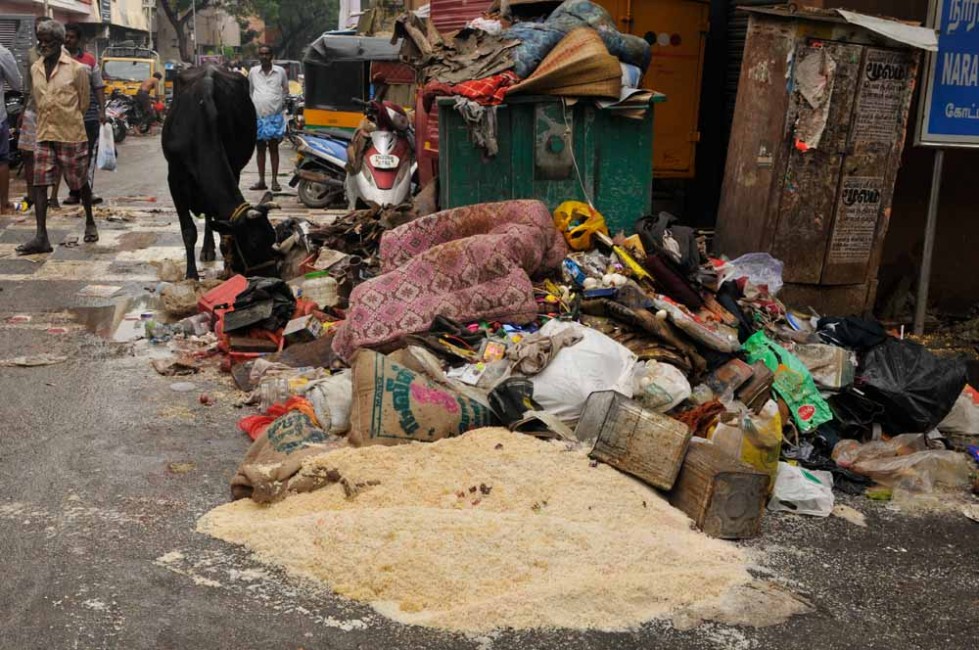
The city
can’t go about its business as long as roads are covered with trash, as long as
there’s a threat of disease, and as long as people can’t walk without holding
their noses. This job, the most important of all, falls on the conservancy
worker, majority of thm Dalit daily
wagers on contract. Across the city, day and night, they went about the
cleaning, going through stuff the water had deposited on the streets: soggy,
mouldy mattresses, wrinkled wooden cupboards, a library of books, an ocean of
plastic, carcasses of dogs and cats, rats and mice. Armed with their hands,
standing on their bare feet, they cleaned the city of its rubbish. When concern
forced the authorities to provide protective gloves and boots to the workers—and
nowhere near as many as required—they looked ill-at-ease working in
black-and-yellow oversized gear. They drew thick lines of white bleaching
powder across the city even as they burnt their hands, a mark of a thankless
job selflessly done.
***
There is a
pleasant calm at Chembarambakkam Lake. The water in the reservoir is down to
harmless levels, and there is barely any evidence of a deluge. It is a
newly-minted picnic spot, bringing the curious in cars to see the dreaded lake
for itself. It is easily accessible, and in spite of a few cops posted there,
people can walk all along its spillway save a small control area. Children dive
in the pool below the sluice gates, from where media reports said the torrent
that submerged Chennai was let loose. In the small pools and streams around it,
there are groups of men squatting with fishing lines, staring down like egrets
looking for food. An old woman has set up shop next to the walkway, spreading
packs of cigarette and peanuts on a cloth. She says this stream of visitors have
started drifting here after the flood. There is a small channel that leads away
from the gates, the route that the 30,000 cusecs of water took when released on
the night of December 1.
The water had nowhere to go. The stream begins to peter out after 300 metres or so, a road cuts it a little further away, and beyond it lie housing plots, apartments and an engineering college. A stream of the Adayar river is a couple of kiolometres further away, according to more than one local person. There’s a network of interconnected water bodies, lakes, streams, and channels, big and small that feed the river. The water from the lake had to go through entire swathes of settlements to meet the river, flooding everything in its path. Natural streams that flow from the lake to the river are hard to find, CMDA approved plots and housing have swallowed them. There are whole settlements coming up around the lake, and along the path of its stream, ensuring that a similar amount of rainfall in the future would wreak more havoc.
For now it is the hot site for disaster tourism—the lake that sank Chennai.
***
Postscript:
On the evening of December 1, when the city was fast shutting down, people made last-ditch attempts to stock supplies. At a grocery store in Nungambakkam, the kind that stocks imported versions of domestically available products, and one of few open anywhere, a crowd was gathering. People bought packaged and frozen food in bulk. It was panic shopping. They paid ₹50 for half a litre of organic milk as they bought cans of it, or double that amount for a packet of oyster mushrooms, the sole vegetable in the shop.
A smartly-dressed woman with a leather clutch walked in. She shouted from the door, “Do you have two packets of goat cheese?” The shopkeeper said, “We are out of stock, madam.” He tapped a few keys on the computer, and said he would procure it from another outlet 15 kilometres away and deliver to her house. There was silence and stunned people looked at each other.
Goat cheese, an essential in the time of the flood.


